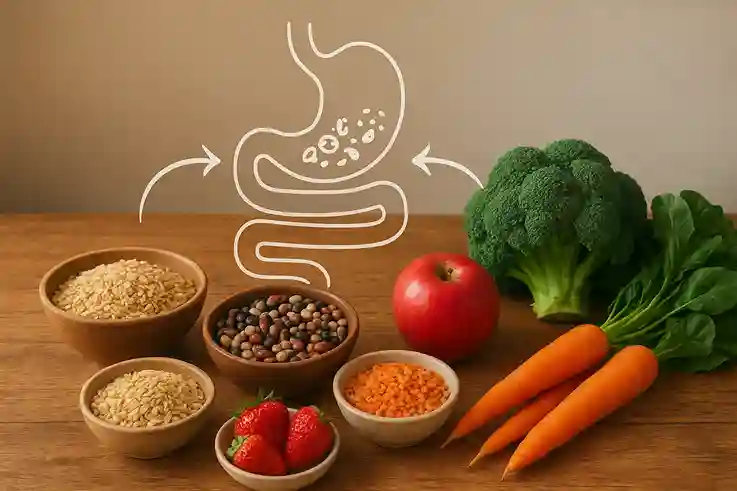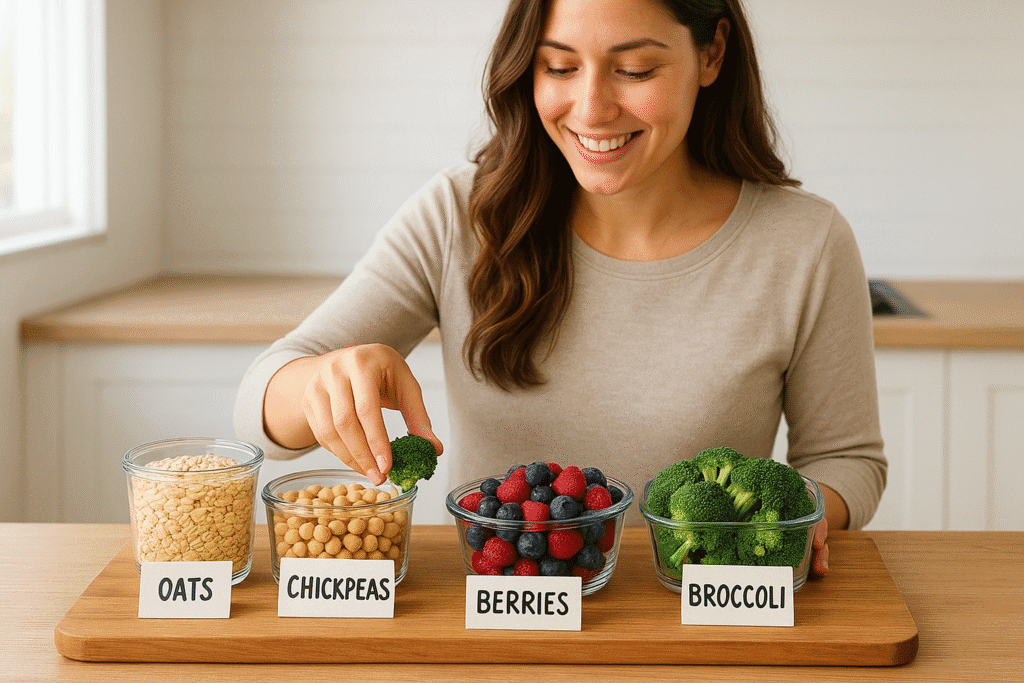Fiber Rich Foods
Fiber rich foods play a powerful role in keeping the body healthy every day. They support digestion, maintain gut balance, and lower the risk of common health problems. A diet lacking fiber often leads to discomfort, irregularity, and poor energy.
Adding more fiber is one of the simplest ways to improve wellness. These foods not only help digestion but also manage weight, balance blood sugar, and protect the heart. Both soluble and insoluble fiber work together to keep the system running smoothly.
In this article, we’ll explore what fiber rich foods are, how they improve digestion, and their many health benefits. You’ll also find practical examples, easy meal ideas, and simple tips to add more fiber into your daily routine.
What Are Fiber Rich Foods?
Fiber rich foods are those that provide dietary fiber, a part of plant-based foods that the body cannot fully digest. Instead of breaking down, fiber moves through the digestive system and supports many important processes.

Soluble Fiber
Soluble fiber is the type that dissolves in water. Once inside the digestive tract, it turns into a soft, gel-like substance. This unique texture slows the movement of food through the stomach and small intestine. The slower pace allows the body to absorb nutrients more efficiently.
One of the key roles of soluble fiber is blood sugar control. By delaying the breakdown of carbohydrates, it prevents sharp spikes in glucose levels. This steady release of sugar into the bloodstream helps maintain energy and reduces the risk of insulin resistance over time.
Soluble fiber also supports heart health. The gel binds to cholesterol particles in the digestive system, especially LDL or “bad” cholesterol. It carries them out of the body before they can enter the bloodstream. Over time, this can help reduce the risk of cardiovascular disease.
Another benefit is satiety, or the feeling of fullness. Foods rich in soluble fiber expand in the stomach, which helps control hunger between meals. This effect makes it easier to maintain a healthy weight without constant snacking.
Everyday sources of soluble fiber include oats, apples, citrus fruits, beans, lentils, carrots, and barley. Adding these foods regularly can create noticeable improvements in digestion, energy, and overall health.
Insoluble Fiber
Insoluble fiber is the type that does not dissolve in water. Instead, it stays intact as it passes through the digestive system. Its main role is to add bulk to stool, making bowel movements smoother and more regular.
This extra bulk speeds up the movement of food through the intestines. By preventing waste from staying too long in the gut, insoluble fiber helps reduce constipation and bloating. It also lowers the risk of developing conditions such as hemorrhoids and diverticulosis, which often occur when stool is hard or difficult to pass.
Another important role of insoluble fiber is cleansing the digestive tract. As it moves through, it acts like a gentle brush, helping to clear out waste and maintain a healthy gut environment. This creates better conditions for nutrient absorption and supports long-term digestive health.
Foods high in insoluble fiber are usually less processed and closer to their natural state. Common examples include whole wheat bread, brown rice, nuts, seeds, green beans, and dark leafy vegetables such as spinach and kale. The skins of fruits and vegetables, like apples and cucumbers, are also excellent sources.
Including insoluble fiber daily ensures your digestive system stays active and balanced. When combined with soluble fiber, it creates a powerful foundation for good gut health and overall well-being.
Why Both Types Matter
Both soluble and insoluble fiber play vital but different roles in the body. Soluble fiber slows digestion, manages cholesterol, and balances blood sugar, while insoluble fiber speeds food through the gut and prevents constipation. When combined, they keep the digestive system working smoothly and improve nutrient absorption. This balance supports long-term energy and helps the body use food more effectively.
A diet rich in mixed fiber has wider benefits beyond digestion. It lowers the risk of heart disease, type 2 diabetes, and other digestive disorders. It also strengthens gut bacteria, which support immunity and overall wellness. The best way to get enough of both types is to eat a variety of foods such as whole grains, fruits, vegetables, legumes, nuts, and seeds. Variety ensures the body receives the full benefits of fiber every day.
How Fiber Helps Digestion

Adds Bulk for Smooth Movement
Fiber is one of the most important elements for maintaining regular and comfortable digestion. Insoluble fiber, in particular, plays a direct role in stool formation. Unlike other nutrients, it does not break down in the stomach or small intestine. Instead, it passes through largely unchanged and mixes with waste, giving stool more bulk and structure.
This added bulk makes stool softer and easier to pass. It shortens the time waste spends in the colon, which prevents it from hardening. As a result, bowel movements become smoother and more consistent, lowering the chances of straining during digestion. This is especially important for reducing discomfort and protecting against issues such as hemorrhoids or anal fissures, which often occur when stools are dry and difficult to pass.
Regular intake of insoluble fiber also trains the digestive system to maintain a natural rhythm. When the intestines are active and moving waste efficiently, the risk of constipation decreases. Over time, this steady flow supports the overall health of the colon and lowers the likelihood of conditions such as diverticulosis.
Everyday sources of insoluble fiber include whole wheat bread, brown rice, nuts, seeds, and vegetables with edible skins. Making these foods part of your diet ensures the digestive tract stays active and reduces strain on the body.
Feeds Gut Bacteria
Not all fiber works the same way in the body. Certain types, mainly soluble fiber, act as prebiotics. This means they provide nourishment for the beneficial bacteria living in the gut. These microbes, often called the gut microbiome, play a vital role in digestion and overall health.
When bacteria break down fiber, they produce short-chain fatty acids such as butyrate, acetate, and propionate. These compounds serve multiple purposes. They protect the lining of the intestines, making it less vulnerable to irritation and harmful bacteria. They also reduce inflammation, which is linked to many chronic diseases, and they help the body absorb minerals more efficiently.
A well-fed gut microbiome supports more than just digestion. It strengthens the immune system by creating a barrier against harmful microbes. It also communicates with the nervous system through the gut–brain axis, influencing mood and mental clarity. Many people notice better focus and energy when their diet includes enough prebiotic fiber.
Common sources of prebiotic fiber include onions, garlic, bananas, asparagus, and oats. Adding these foods rich in fiber to meals encourages a healthier gut environment. Over time, a strong microbiome can improve digestion, immunity, and even emotional balance.
Prevents Constipation
A lack of fiber in the diet often leads to sluggish digestion. When food moves slowly through the intestines, water is absorbed from the stool, making it hard and dry. This slows down bowel movements and can cause constipation, one of the most common digestive complaints.
Fiber helps prevent this problem in two ways. Soluble fiber absorbs water and creates a soft, gel-like texture that keeps stool moist. Insoluble fiber adds bulk, helping stool move steadily through the colon. Together, they maintain the right balance of softness and structure, ensuring waste exits the body without strain.
By keeping stool soft and easy to pass, fiber also reduces bloating, cramping, and discomfort that come with irregular digestion. Over time, it lowers the risk of diverticulosis, a condition where small pouches form in the colon wall due to pressure from hard stools. These pouches can become inflamed or infected, leading to painful complications.
Eating a variety of fiber rich healthy foods, such as whole grains, fruits, vegetables, and legumes, is the most effective way to prevent constipation naturally. Along with proper hydration, this daily intake creates long-term digestive comfort and protects the colon from stress.
Fiber Rich Foods for Gut Health
A balanced diet with foods rich in fiber supports digestion and long-term health. Whole grains, legumes, fruits, and vegetables each provide unique types of fiber and nutrients that work together to keep the gut strong.

Whole Grains
Grains are among the best sources of fiber. Unlike refined grains, they keep their bran and germ, which contain most of the fiber. Oats, barley, and brown rice are excellent choices. Oats provide soluble fiber that lowers cholesterol and supports healthy blood sugar levels. Barley helps soften stool and promotes steady digestion. Brown rice adds insoluble fiber that keeps food moving through the intestines. Including a variety of whole grains ensures both soluble and insoluble fiber are present in your diet.
Legumes
Beans, lentils, and chickpeas are rich food in fiber and also supply protein and minerals. They are especially high in soluble fiber, which forms a gel-like substance in the gut. This slows digestion, improves nutrient absorption, and feeds beneficial bacteria. Eating legumes regularly can reduce constipation, stabilize blood sugar, and support long-lasting energy. Many people find that swapping meat for legumes in a meal increases fiber intake without sacrificing fullness.
Fruits
Fruits like apples, pears, and berries are excellent sources of both soluble and insoluble fiber. Apples and pears, especially when eaten with their skins, provide bulk that improves bowel regularity. Berries are packed with soluble fiber, antioxidants, and water content that support hydration and gut balance. These foods rich of fiber also deliver vitamins and natural sweetness, making them an easy daily choice for digestive wellness.
Vegetables
Vegetables provide an unmatched range of fiber types and digestive benefits. Broccoli contains insoluble fiber that keeps the intestines active, along with compounds that may protect against colon issues. Carrots supply soluble fiber that helps regulate cholesterol and blood sugar. Leafy greens like spinach and kale are fiber rich healthy foods that also deliver magnesium, a mineral that supports muscle function in the digestive tract. Eating a variety of vegetables each day strengthens gut function and reduces the risk of constipation.
Fiber Rich Foods for Gut Health
| Food Group | Examples | Main Fiber Type | Digestive Benefit |
|---|---|---|---|
| Whole Grains | Oats, barley, brown rice | Soluble + Insoluble | Improves stool bulk, regulates sugar, prevents constipation |
| Legumes | Beans, lentils, chickpeas | Mostly Soluble | Feeds gut bacteria, supports energy, eases constipation |
| Fruits | Apples, pears, berries | Soluble + Insoluble | Adds bulk, hydrates stool, balances gut bacteria |
| Vegetables | Broccoli, carrots, greens | Insoluble + Soluble | Keeps intestines active, lowers cholesterol, prevents bloating |
Daily Health Benefits Beyond Digestion
Fiber rich foods support more than just digestion. They also improve heart health, manage blood sugar, and reduce risks linked to chronic conditions.

Helps Lower Cholesterol Naturally
One of the most important roles of soluble fiber is its ability to lower cholesterol. When eaten, soluble fiber binds with bile acids and cholesterol in the digestive tract. Instead of being absorbed into the bloodstream, these compounds are carried out of the body as waste. This process gradually lowers levels of LDL, often called “bad” cholesterol, which is strongly linked to heart disease.
Regular intake of foods rich in fiber has been shown to improve overall cardiovascular health. Oats, beans, lentils, apples, and barley are particularly effective because they contain high levels of soluble fiber. Including them in daily meals provides a steady defense against plaque buildup in arteries and reduces long-term risks of heart conditions.
Unlike restrictive diets, adding fiber rich healthy foods does not require cutting out entire food groups. It is a natural, simple, and sustainable way to protect heart health. With consistent intake, the benefits compound over time, making fiber an essential nutrient for anyone concerned about cardiovascular wellness.
Balances Blood Sugar Levels
Fiber plays a crucial role in controlling how the body processes carbohydrates. When you eat foods rich in fiber, digestion slows, and glucose is released more gradually into the bloodstream. This prevents the sharp spikes and rapid drops in blood sugar that are common after eating refined carbohydrates.
For people managing diabetes or insulin resistance, this steady release is especially valuable. A diet with fiber rich food helps the body maintain consistent energy and lowers the strain on insulin production. Over time, this can improve insulin sensitivity and reduce the risk of long-term complications linked to blood sugar imbalance.
Even for those without diabetes, the benefits are clear. Stable blood sugar means fewer mid-day crashes, less fatigue, and better appetite control. Fiber rich healthy foods such as oats, lentils, apples, and leafy greens provide a natural way to balance energy and support metabolic health without drastic dietary changes.
Supports Weight Management
Fiber is one of the most effective nutrients for controlling hunger naturally. Foods rich of fiber add bulk to meals, which stretches the stomach and triggers satiety signals. This feeling of fullness lasts longer than meals made with refined carbohydrates or low-fiber foods. As a result, cravings decrease, and the urge to overeat or snack on processed foods is reduced.
Fiber rich healthy foods also tend to be lower in calories while still offering high volume. Vegetables, fruits, legumes, and whole grains provide plenty of bulk without excess energy intake. This allows people to eat satisfying portions while still keeping calorie levels in check, a key factor for weight management.
Another advantage of high-fiber meals is their slower digestion. Because fiber slows the breakdown of carbohydrates, energy is released gradually, keeping you full for extended periods. This steady energy supports better meal planning, fewer hunger crashes, and improved portion control. Over time, including foods rich in fiber becomes a sustainable and natural way to maintain a healthy weight.
Lowers Risk of Digestive Disorders
A consistent intake of rich food in fiber provides strong protection against many common digestive problems. By keeping stool soft and bowel movements regular, fiber reduces the risk of constipation, which is one of the most frequent digestive complaints. Less straining also lowers the chance of developing hemorrhoids, a painful condition often caused by hard stools.
Long-term benefits are equally important. Insoluble fiber helps prevent diverticulosis, a condition where small pouches form in the walls of the colon. These pouches can become inflamed or infected, leading to serious complications. A steady supply of fiber keeps the colon active and reduces the pressure that causes such issues.
Fiber also plays a central role in maintaining a balanced gut microbiome. A healthy mix of bacteria in the intestines supports digestion, strengthens immunity, and lowers inflammation. This balance is crucial for protecting the colon and lowering risks of disorders that can develop over time.
By eating a wide variety of fiber rich healthy foods—whole grains, legumes, fruits, and vegetables—you create a natural defense system for your digestive health. Each type of fiber works differently, and together they form a shield that keeps the gut resilient for years to come.
Easy Fiber Rich Foods to Add Daily
Building a diet around fiber rich foods does not need to be complicated. Simple choices at each meal can improve digestion and overall wellness. By including a variety of fiber rich healthy foods, you can meet daily needs without major changes to your routine.

Sample One-Day Plan with Fiber Rich Foods
The table below shows how simple meal and snack choices can include fiber rich foods throughout the day for better digestion and health.
| Meal | Fiber Rich Foods Included | Benefits for Digestion & Health |
|---|---|---|
| Breakfast | Oatmeal with berries, chia seeds, and whole grain toast with avocado | Provides soluble and insoluble fiber, supports fullness, and balances blood sugar |
| Snack | Apple with skin and a handful of almonds | Adds bulk, nourishes gut bacteria, and curbs hunger between meals |
| Lunch | Lentil soup, mixed bean salad, and side of leafy greens | Rich food in fiber, promotes bowel regularity, and strengthens gut microbiome |
| Snack | Air-popped popcorn and cucumber slices | Light, crunchy foods rich of fiber that prevent overeating |
| Dinner | Brown rice bowl with chickpeas, broccoli, and carrots | Fiber rich healthy foods that improve stool bulk and long-term digestive health |
How Much Fiber Is Enough?
Most people eat far less fiber than they need each day. The recommended daily intake varies by age and gender, but on average, adults should aim for 25–38 grams of fiber daily. Children also need adequate amounts to support growth and healthy digestion. Since many diets are high in refined foods, reaching these goals often requires adding more fiber rich foods like whole grains, legumes, fruits, and vegetables.
| Age Group | Recommended Daily Fiber Intake | Example Portions That Meet Needs |
|---|---|---|
| Children (4–8 yrs) | 17–20 grams | 1 apple with skin + 1 cup carrots + ½ cup beans |
| Girls (9–18 yrs) | 22–25 grams | 1 pear + 1 cup broccoli + 1 cup lentils |
| Boys (9–18 yrs) | 25–31 grams | 1 cup oatmeal + 1 banana + 1 cup chickpeas |
| Women (19–50 yrs) | 25 grams | 2 slices whole grain bread + 1 cup beans + 1 cup berries |
| Men (19–50 yrs) | 30–38 grams | 1 cup barley + 1 pear + 1 cup black beans |
| Older Adults (50+) | 21–30 grams | 1 orange + 1 cup brown rice + 1 cup lentil soup |
According to the U.S. Dietary Guidelines, adults should aim for at least 25–38 grams of fiber daily (Dietary Guidelines for Americans, 2020–2025)
Side Effects and Cautions
While fiber rich foods are vital for digestion, adding too much fiber too quickly can cause temporary discomfort. A gradual increase helps the body adjust.
Bloating and Gas
Eating a sudden large amount of foods rich in fiber can sometimes cause bloating or excess gas. This reaction is normal and happens because the gut bacteria are adapting to the increased supply of fermentable fiber. As these bacteria break it down, gases are released, leading to temporary discomfort. Over time, the digestive system usually adjusts, and these effects lessen as the gut microbiome becomes stronger and more balanced.
Importance of Hydration
Fiber works best when it is paired with enough fluids. Without water, fiber cannot move smoothly through the digestive tract. Drinking plenty of fluids helps keep stool soft, prevents constipation, and reduces discomfort when fiber intake is high. Proper hydration ensures that fiber rich foods deliver their full benefits for digestion and overall wellness.
Finding the Right Balance
Balance is key when it comes to fiber intake. Too little fiber slows digestion and increases the risk of constipation, while too much without proper hydration may lead to bloating or discomfort. Eating a varied mix of fiber rich healthy foods in moderate amounts, paired with enough water, ensures the digestive system runs smoothly and the body gains the full health benefits.
Disclaimer
This article is for informational purposes only and not a substitute for professional medical advice. Always consult a healthcare provider for personalized guidance on diet and fiber intake.
FAQs About Fiber Rich Foods
Conclusion
Fiber is more than just a nutrient — it is a foundation of good health. Both soluble and insoluble fiber keep digestion smooth, support gut bacteria, and lower the risk of common digestive problems. A balanced diet filled with fiber rich food such as whole grains, legumes, fruits, and vegetables provides lasting benefits beyond digestion, including better heart health, stable blood sugar, and easier weight management.
Many people fall short of daily needs, but adding small changes makes a big difference. Choosing snacks like roasted chickpeas, apple slices, or air-popped popcorn, and including foods rich in fiber at every meal, ensures your body gets the variety it needs. By focusing on fiber rich healthy foods, you not only improve your digestive system but also strengthen your overall well-being for the long term.
Have a favorite high-fiber snack or meal? Share your go-to fiber rich foods in the comments and inspire others to eat healthier!

Nick William is a dedicated travel blogger with a passion for uncovering hidden destinations and sharing authentic experiences from around the world. With a background in digital media and storytelling, he has developed a unique style that combines detailed research, vivid descriptions, and personal insights. His goal is to help readers not only plan their journeys but also connect with the culture, people, and stories behind each place.
When Nick isn’t exploring new cities or trekking off-the-beaten paths, he enjoys capturing moments through photography, reading history books, and sipping coffee while drafting his next adventure. His writing brings destinations to life, making every reader feel like a fellow traveler on the journey.


